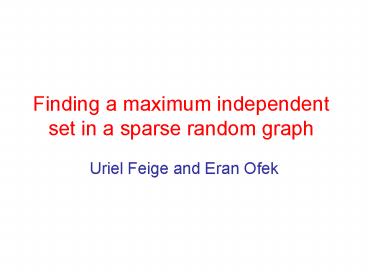Finding a maximum independent set in a sparse random graph
1 / 20
Title:
Finding a maximum independent set in a sparse random graph
Description:
On random graphs, no polynomial time algorithm is known to find max-IS. ... Can also certify maximality, and handle semirandom graphs [Feige, Krauthgamer 2000] ... –
Number of Views:140
Avg rating:3.0/5.0
Title: Finding a maximum independent set in a sparse random graph
1
Finding a maximum independent set in a sparse
random graph
- Uriel Feige and Eran Ofek
2
Max Independent Set
- Largest set of vertices that induce no edge.
- NP-hard, even to approximate.
- NP-hard on planar graphs.
- Polynomial time algorithms on simple graphs
trees (greedy), graphs of bounded treewidth
(dynamic programming).
3
Complexity on most graphs
- On random graphs, no polynomial time algorithm is
known to find max-IS. - Holds for all densities except for extremely
sparse or extremely dense graphs. - Best algorithmic lower bound greedy.
- Best upper bound theta function.
4
Planted models
- Model the case that a graph happens to have an
exceptionally large IS. - Random graph with edge probability d/n.
- All edges within a random set S of vertices are
removed. - When dS gt n log n, the set S is likely to be
the maximum IS.
5
Planted model
6
Planted model
- S
7
Planted model
- S
8
Some known results
- When dn/2, can find S of size Alon,
Krivelevich, Sudakov 1998. - Can also certify maximality, and handle
semirandom graphs Feige, Krauthgamer 2000. - When dlog n, can find S of size , even
in semirandom graphs, up to the point when it
becomes NP-hard Feige, Kilian 2001
9
Our results
- Allow d to be (a sufficiently large) constant.
- W.h.p., the random graph) has no independent set
larger than n (log d)/d. - Plant S of size
- We find max independent set in polynomial time.
- New aspect S is not the max-IS. Complicates
analysis.
10
S is not max-IS
- V-S
S
11
Some related work
- Many of the techniques in this area were
initiated in work of Alon and Kahale (1997) on
coloring. - Amin Coja-Oghlan (2005) finds a planted
bisection in a sparse random graph. The min
bisection is not the planted one. Amins
algorithm is based on spectral techniques and
certifies minimality.
12
Greedy algorithm
- Select vertex i to put in solution (e.g., vertex
i may be vertex of degree 0,
degree 1,
or of lowest degree). - Remove neighbors of i.
- Repeat on G i N(i).
13
Simplify analysis
- 2-stage greedy
- Select an independent set I.
- Remove neighbors of I.
- Finish off by exact algorithm.
- Last stage takes polynomial time if G-I-N(I) has
simple structure.
14
Required properties of I
- Partition graph into Independent, Cover and
Undecided. - No edge within I.
- No edge between I and U.
- Every vertex of C must have at least one neighbor
in I. - Note U is then precisely V(G) I N(I).
15
How we select I
- Initialization. Threshold t d(1 - S/2n) lt d.
- Put vertices of degree lower than t in I.
- Put vertices of degree higher than t in C.
- Iteratively, move to U
- Vertices of I with neighbors in I or U.
- Vertices of C with lt 4 neighbors in I.
16
End of first step
- I
C - U
17
Theorems for planted model
- Lem S highly correlated with max-IS.
- Lem Low degree highly correlated with S.
- Thm I is contained in max-IS.
- (Difficulty in proof max-IS is not known not
only to the algorithm, but also in analysis.) - Thm G(U) has simple structure.
18
Algorithm for G(U)
- Iteratively
- Move vertices of degree 0 to I.
- Move vertices of degree 1 to I, and their
neighbors to C. - Use exhaustive search to find maximum IS in each
of the remaining connected components. - Thm CC of 2-core have size lt O(log n).
19
Why did we consider 2-core?
- Asymmetry vertices of S enter U more easily than
vertices of V-S. - A tree might have most its vertices from S.
- In a cycle, at least half the vertices must be
from V-S. - Easier to show that U has no large cycles then
to show that has no large trees.
20
Conclusions
- Planted model in sparse graphs, in which planted
solution is not optimal. - Natural algorithm provably finds max-IS in
planted model. (All difficulties are hidden in
the analysis.) - Improve tradeoff between d and S.
- Output matching upper bound on max-IS.































